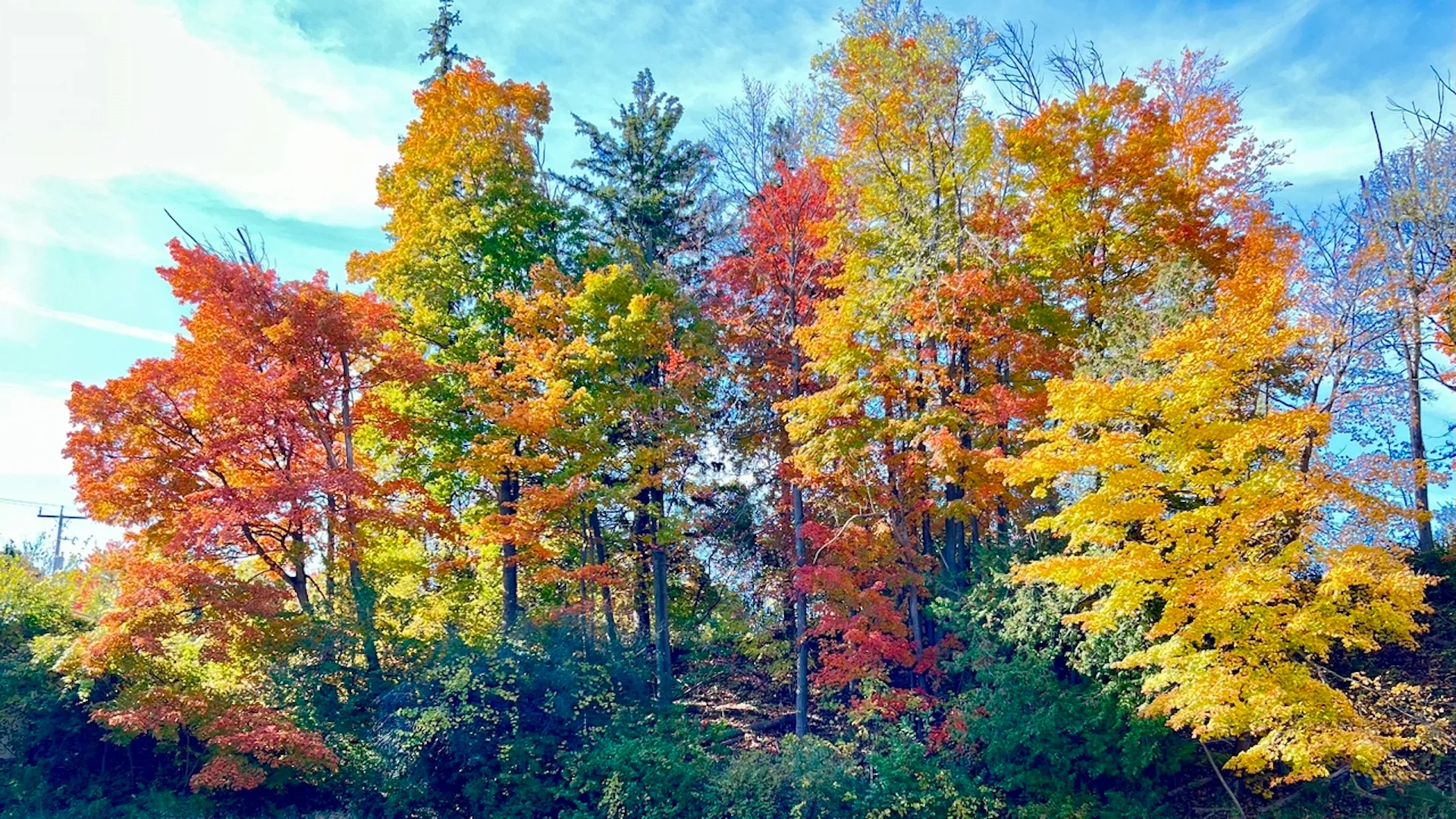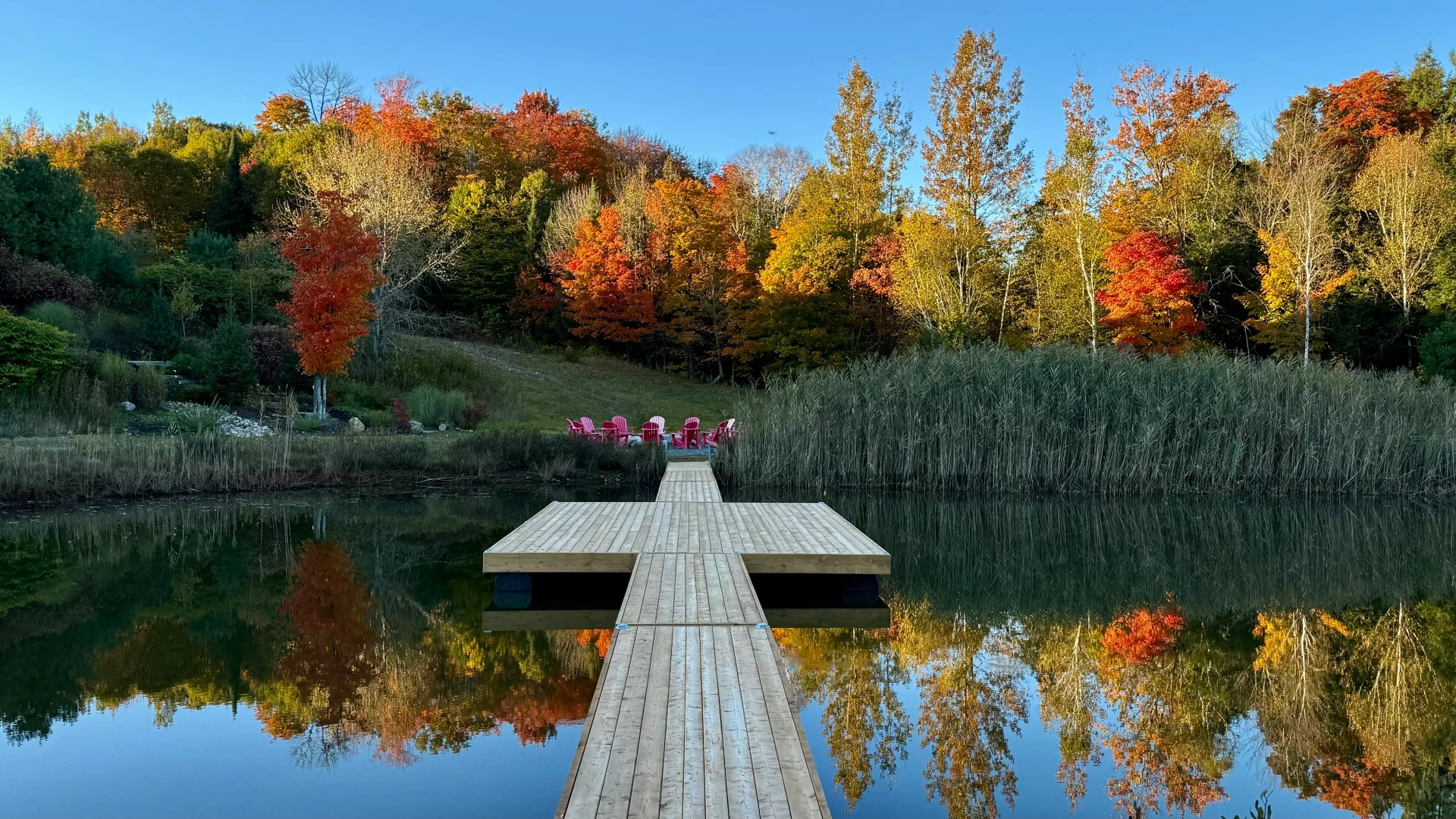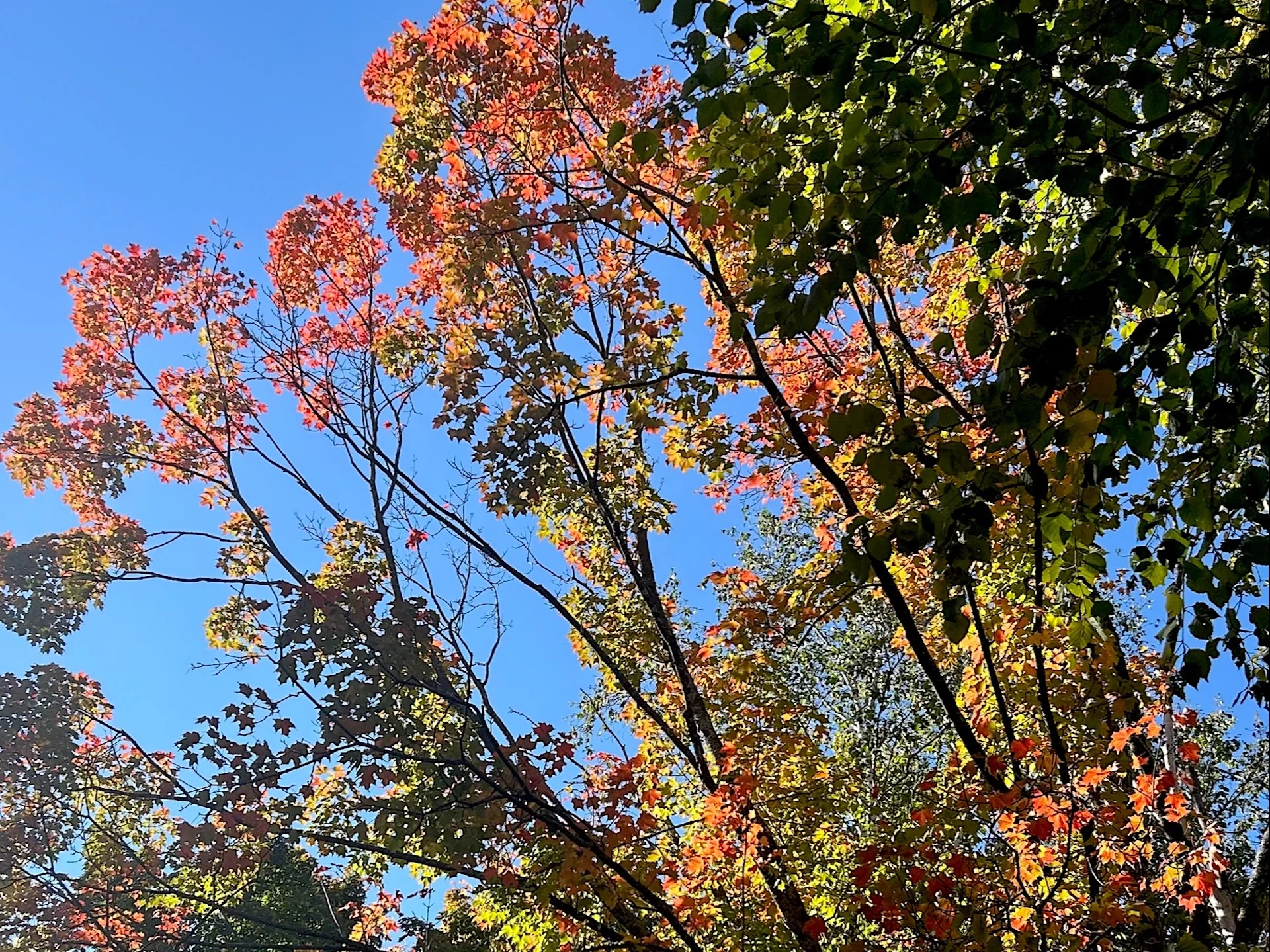
Fall colours showing in Ontario after warm September 'paused' foliage
October has initiated a quick transformation of the leaf colours in Ontario with parts of the province currently at their peak, while the remaining locales won't be far behind as the month progresses
If you love autumn for the stunning scenery that can unfold during the season, then you will like what Ontario Parks has to say about the fall foliage for the remainder of October.
The Ontario Parks' Fall Colour Report shows "great" changes in northern and central sections of the province, with parks in southern areas just beginning their colour transformation, according to Dave Hunt, Ontario Parks market development specialist and media/influencers spokesperson.
"We are expecting a great rest of October for viewing colours," said Hunt, in a recent interview with The Weather Network.
Visit our Complete Guide to Fall 2024 for an in-depth look at the Fall Forecast, tips to plan for it and much more!
As part of its report, Ontario Parks offers a progression map that highlights the current percentage of the leaf colour change at each site.
Canadians outside of Ontario, meanwhile, can typically find websites offering recommendations on where to go to view the peak fall colours.

Fall foliage in Huntsville, Ont., taken in October 2024. (Tyrrell Jason Rajapakse/Submitted to The Weather Network)
"There is always about a month of great colours from when things start, and then new trees start to change," said Hunt. "It's not a matter of a couple days and you miss the colours. It goes on for weeks or a month, obviously, depending how far north or south you are."
Warm September put the fall foliage on 'pause'
It appears the conversion is back on track after a warm September, even record-breaking in parts of northern Ontario, seemingly put a "pause" on colour change at many parks farther south, Hunt said.
"Colours should change quickly again now as we’ve just had some colder weather [during] the past few days in the [Greater Toronto Area] GTA and parts of southern Ontario," said Hunt.
Interestingly, though, Algonquin Provincial Park and some locales north of there had a brief cold snap in early September, resulting in a rapid beginning to the colour changing, he noted.
However, the rest of September was mild and Algonquin Provincial Park colours have actually been a "bit slow to peak" when compared to recent years.
The news of the "great" foliage finish to October also comes on the heels of a rainy summer in parts of southern Ontario, especially in Toronto, which recorded its wettest on record.

Fall leaves, taken in Severn, Ont., on Oct. 12, 2024. (Nathan Howes/The Weather Network)
"The rainy weather did seem to put some stress on trees, as many people reported early leaf [colour changes] in some trees around late August and early September. Since then, the weather has been great and [the] colour change seems consistent with other years," said Hunt.
As long as the weather co-operates without too much wind or rain, the GTA and other parts of southern Ontario should be enjoying plenty of colour for the rest of October, he added.
Some Ontario parks see a surge in colour change in a short time
As of Oct. 9, some parks that have reached 80 per cent or higher of their colour changes include Lake Superior Provincial Park, Kettle Lakes Provincial Park, Lake St. Peter Provincial Park, Restoule Provincial Park and Mikisew Provincial Park.
Hunt noted that most of those parks were only at 50 per cent or 60 per cent colour change just a week ago, so there has been "quite a jump."
"Is it an exact science in terms of the percentages? Of course not," said Hunt. "You will still see lots of green out there, but it's been a quick change for sure."
Many other parks are currently around 50 per cent colour change, including southern sites such as Frontenac Provincial Park near Kingston, and Bronte Creek Provincial Park in Oakville.

Fall leaves, taken in Orillia, Ont., on Oct. 12, 2024. (Nathan Howes/The Weather Network)
"Our best guess [is] that there is going to be a good, quick change farther south in Ontario now," said Hunt. "We're in the midst of the change across the province now. Things are well underway."
Most ideal locales right now
If you are planning to visit any Ontario provincial park north of Barrie or near Sudbury, then now is "a great time to get out viewing the colours," Hunt said. Farther north, Lake Superior Provincial Park is currently at peak viewing.
As colour changes slowly progress to the parks in southern Ontario, mid-to-late October is expected to be ideal at sites such as Inverhuron Provincial Park, Bronte Creek Provincial Park, Balsam Lake Provincial Park and Bonnechere Provincial Park, he added.
Now that the colour change is ongoing, the process tends to accelerate, Hunt said, noting the Fall Colour Report gets daily updates from the parks. So, expect at least a "few more weeks of great colours."
"Since we’re lucky to have such great forest diversity in Ontario, even after the bright-red maples have peaked, we still have the golden encore to look forward to as the birch and poplar trees turn yellow, along with the tamarack trees in places like Algonquin Provincial Park," said Hunt.
If you're planning on visiting a park soon, remember it can get "quite busy" for fall-colour viewing, he said. There are more than 70 provincial parks that allow you to book a day-use permit up to five days in advance of arrival.
"We strongly recommend all visitors purchase their day-use permit in advance to guarantee access, even if they have a seasonal permit. These advanced, daily vehicle permits can be purchased online," said Hunt.
Hunt recommends you check the Fall Colour Report frequently since colours change often. Once you decide on a site to visit, check its social media accounts for any last-minute tips.
"This time of year, the weather can change quickly and the days are shorter, so always pack for the weather and plan your hikes to return well before sunset," said Hunt.
Late September or early October is when leaves 'typically' start to change colour
The fall colour season can start as early as August sometimes, but it's typically in late September and early October, said Megan Birrell, former assistant program co-ordinator and current tourism marketing development specialist with Ontario Parks, in an interview with The Weather Network in 2023.

File photo. (Kitty Yip/Submitted to The Weather Network)
“If you have that consistent temperature, you will see a longer fall colour period. That could be a week or more than a week. If we have [those] consistent warm days and cool nights, we will see a longer fall season,” said Birrell.
She stated that trees want to recoup the energy and resources they put into acquiring their leaves before the climate becomes too harsh for them to continue.
"Think of our cold winters. They are not ideal for leaves. After all, the leaves are what's making the food for the tree. Once those leaves are destroyed, the [trees aren't] so happy," said Birrell. "What they do instead is go dormant, [which] is how we see the fall colours change."
WATCH: Take in the spectacular fall foliage of these picturesque Ontario parks
Fall foliage 'highly regulated' by the trees
When we talk about the colour-changing process in the fall, we have to understand that it is a procedure that is "highly regulated" by the trees, no matter what species they are, said Ingo Ensminger, biology professor and researcher with the University of Toronto Mississauga (UTM), in an interview with The Weather Network in 2023.
The main triggers behind the change are temperatures and day length, which determine when the colours actually switch.
"The purpose of the changing colours is the tree is preparing for the winter season," said Ensminger. "The change in colour actually indicates that the tree starts to retrieve all the nutrients from the leaves, which means everything that is vaguely useful for the tree is broken down into smaller products."

File photo. (Scott/Submitted to The Weather Network)
After all the "nice colours have disappeared," what remains of the leaf is basically a skeleton of the tree, Ensminger said.
"The tree makes a lot of use of the environmental information like temperature and day length, and day length doesn't change at all," said Ensminger.
Stages of transformation depends on tree type
Leaves will go through stages in the colour-change sequence.
During the summer, there comes a time when most trees "actually" sense a change is coming in the day length, triggering a series of initial steps for the colour modification, regardless of the temperature, Ensminger said.
"They use temperature in order to modulate the sequence of fall steps," he said.

(Unsplash)
In terms of timing and how long it takes, Birrell said it depends on the tree type.
"The different types of trees change colours at different times during the season and for different durations. Those iconic red maple leaves that we kind of look for every single year come earlier in the season," said Birrell. "They are really dependent on that time of day."
After those red and orange colours peak, we see leaves on trees such as birch, poplars and Tamarix change to a yellow-gold hue, typically after the maple leaf season, referred to as a golden encore, she said.
SEE ALSO: Why do leaves change colour in the fall?
"It's honestly an amazing sight, especially at Algonquin Park. It really depends on the type of tree, the variability in the weather, how consistent it is, and of course, the length of sunlight in the day," said Birrell.
And the time it takes for the leaves to fall onto the ground after changing colours depends on the weather, Birrell reiterated. Factors such as high winds and storms can speed up the leaf drop.

File photo. (Caroline/Submitted to The Weather Network)
"A leaf that hasn't even actually changed colour could fall off if we have a lot of wind and it really just depends on the season, the tree and the weather we've been experiencing," said Birrell.
Does climate change factor into the foliage?
When mentioning climate change in the conversation on fall foliage, it is not as simple as it appears.
It's not a question of how climate change can actually affect leaf colours, Ensminger said, but rather, "how does temperature actually trigger and delay this autumn process to some extent?"
"The short answer to that is yes. If the falls are getting warmer, that will very likely delay the occurrence of the fall colours. This is what I think a lot of observations and a lot of studies already demonstrate," said Ensminger. "Warmer falls lead to a delay in the onset of the fall colours."

File photo. (Calvin Hanson Photos/Submitted to The Weather Network)
However, the UTM biology professor doesn't think that a warm autumn has any negative impact on the formation of fall colours because the sequence of events starts with the breakdown of chlorophyll -- the green leaf colour, which slowly degrades and then actually makes all the carotenoids visible.
"Carotenoids are the yellow and orange pigments in the leaf that are all [there] during the summer, and they only become visible in the fall when the chlorophylls have been broken down," said Ensminger. "It's not that they were late in the fall, like many people think, that they all of a sudden are being produced. They have only been masked by the chlorophylls to that point."
As a result, Ensminger doesn't think our changing climate will necessarily alter the sequence of the events.
WATCH: Stunning aerial of the leaves changing in Toronto
However, if the trees experience droughts or a very hot summer, what climate change will "probably do" is modify the fall schedule to a "much, much larger" extent than just warm autumn temperatures, he said.
"The reason for that is this senescence process...where leaves are actually determined to be set at one point and where they're no longer useful for the tree, that's something that is accelerated during hot temperatures and drought, [when] the trees experience stress," said Ensminger.
Using Algonquin Park as a source, Birrell said historical data from the park over several decades indicates a "point of consistency" when comparing autumns and leaf changes, even during the warmer and cooler summers.
"Having those warmer days that we'll see in those warmer summers and those warmer falls is ideal for fall colours. We are still seeing, typically, that the peak is around the end of September and [into early] October..." said Birrell.
WATCH: Aerial view of leaves changing in the GTA
Thumbnail courtesy of Aantje/Submitted to The Weather Network, taken in Wingham, Ont., in October 2024.
Follow Nathan Howes on X, formerly known as Twitter.











